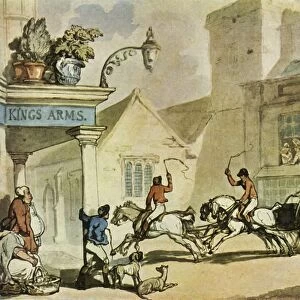Robert Brown, British botanist C016 / 4962
![]()

Wall Art and Photo Gifts from Science Photo Library
Robert Brown, British botanist C016 / 4962
Robert Brown (1773-1858), Scottish botanist. Brown, who travelled on an expedition to Australia, spent years working on plant taxonomy, establishing the classification of two major divisions of plants (gymnosperms and angiosperms). He also observed an essential part of living cells, which he named the nucleus. His famous 1827 observation of erratic motion by pollen grains in water (Brownian motion) was later explained as evidence for the existence of molecules. Brown became the first Keeper of the Botanical Department at the British Museum. Photographed circa 1854 by the Maull and Polyblank photographic studio
Science Photo Library features Science and Medical images including photos and illustrations
Media ID 9205653
© NATURAL HISTORY MUSEUM, LONDON/SCIENCE PHOTO LIBRARY
1854 Biologist Botanist Chair Elderly Fellow Of The Royal Society Looking At The Camera Natural History Natural History Museum Naturalist Portrait Scientist Scottish Seated Maull And Polyblank Robert Brown
EDITORS COMMENTS
This print showcases Robert Brown, a distinguished British botanist who made significant contributions to the field of plant taxonomy. Born in Scotland in 1773, Brown embarked on an expedition to Australia where he dedicated years of his life studying and classifying plants. His groundbreaking work led him to establish the classification of two major divisions of plants: gymnosperms and angiosperms. Beyond his taxonomical achievements, Brown also made a remarkable discovery within living cells – he identified and named the nucleus, an essential component that plays a vital role in cell function. In addition, his observation of pollen grains exhibiting erratic motion when placed in water (known as Brownian motion) provided evidence for the existence of molecules. In this portrait captured around 1854 by the renowned Maull and Polyblank photographic studio, we see Robert Brown seated on a chair with an air of wisdom and experience befitting his status as one of history's most influential botanists. As the first Keeper of the Botanical Department at the British Museum, he played a pivotal role in advancing botanical research during his time. This photograph serves as a powerful reminder not only of Robert Brown's immense contributions to science but also highlights his dedication towards understanding nature's intricate beauty through meticulous study and observation.
MADE IN THE USA
Safe Shipping with 30 Day Money Back Guarantee
FREE PERSONALISATION*
We are proud to offer a range of customisation features including Personalised Captions, Color Filters and Picture Zoom Tools
FREE COLORIZATION SERVICE
You can choose advanced AI Colorization for this picture at no extra charge!
SECURE PAYMENTS
We happily accept a wide range of payment options so you can pay for the things you need in the way that is most convenient for you
* Options may vary by product and licensing agreement. Zoomed Pictures can be adjusted in the Cart.













